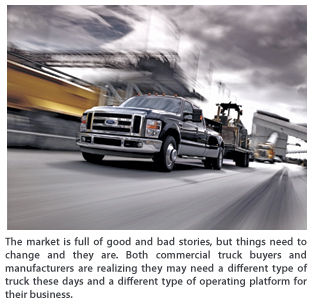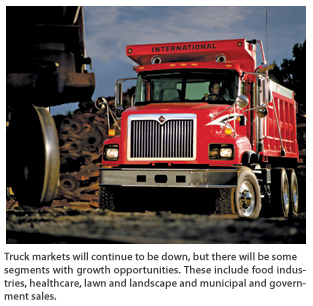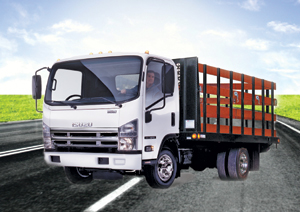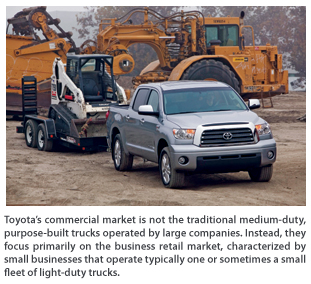On the Road Again
Nose-diving sales, bankrupt companies and government bailouts have all taken their toll on the long, tough road of the commercial truck market. Brothers in arms like Sterling and General Motors (GM) medium-duty chassis cabs have been lost. Though the war against slumping sales continues, it looks like there’s a break in the battle, bringing relief and a sense of hope for the future.

This time last year, the medium-duty truck market was in dire straits thanks to a 26 percent increase in diesel fuel prices and the extreme volatility of the stock market. The economy has dramatically impacted the medium-duty range because many of the vehicles are used in service-type industries.
The industry has seen a drop of almost 70 percent since the high of 2006, according to Bloom. In the compact equipment sector, there are typically two different groups of truckers — the major fleet operators and the smaller independent contractors. There is also the government side, which has seen some signs of recovery thanks to stimulus funding, but independent contractors are still being impacted. Luckily, folks like Ford, which has been the leader in the commercial truck market for 24 years with 43 percent of the Class 2 to 7 segment are also seeing signs of recovery.
“Our commercial customers — from RV and body builders to equipment upfitters and dealers — are seeing increased demand,” says Len Deluca, director of commercial trucks, sales and marketing for Ford. “They’re taking advantage of our full range of commercial vehicle offerings in our Super Duty lineup. That’s good news for us.”
Ford also sees an increased demand for medium-duty (F-650 and F-750) production. “Our customers are cautiously increasing their orders,” Deluca says. “There are companies buying trucks who stayed out of the market the last few years.”
Within the last two years, true truckers — hauling horse trailers, towing large equipment, using dump beds and pushing snow — have stayed in the market and many image kings — personal use customers, boats and toy haulers, etc. — have left, says Nantaé Rayners, truck marketing manager for Toyota Motor Sales USA Inc.

Staying Solid in a Soft Economy
The economy is affecting profits. Smart contractors are repositioning fleet expenses to manage the threat. For the medium-duty truck market, adaptation is the key. The new economy has brought new buying trends. For instance, buyers interested in trucks are downsizing. Whereas in years past you may have seen someone driving a burly Class 6 medium-duty chassis cab, now they are piloting smaller trucks that better fit their needs.
Operating costs are also a major consideration of today’s truck buyers. Sure, the machine costs you money up front, but not doing your homework on the maintenance schedule and cost of repair could turn your trusty jobsite steed into a mechanical money-gobbling monster. The truck business is similar to the car business, in that it’s talking about a transaction price — not just what’s the discount off the retail price.
“What it comes down to is ‘I have a vehicle and a need for a new vehicle, so what is the transaction price of this vehicle vs. another?’” explains Bloom. “And people can look at incentives. There are discounts on bodies and chassis. There are discounts based on vocation and based on financing. There are dealer programs out there. If you’re interested in a quality vehicle, now is the best time to consider it.”
Just as it did when diesel vehicles had to install a diesel particulate filter (DPF) to meet engine emissions standards in 2008, the cost for the new engine technology to hit emissions standards for 2010 is going to send some buyers into various states of sticker shock.

If you looked at a $30,000 vehicle in 2005 — the 2008 $3,000 to $5,000 price increase plus another $3,500 to $5,000 price hike for 2010 technology puts that same machine around $40,000 to $45,000.
If you’re in a state with stringent emissions standards — like California — that is pushing diesel on-highway engine users to adopt the best available technology (BAT) to improve the air quality, the price of new technology is unavoidable. For the rest of us, it’s only avoidable until the rest of the country falls in line. For some potential truck buyers, these price hikes have increased the interest in gasoline-powered trucks.
The low rumbling of an idling diesel has long been the call of the workman’s truck, but saving green reigns supreme. So gas has been a growing market for vocational medium-duty trucks. Without the extra technology needed to meet the diesel emissions standards, gasoline-powered trucks tend to be less expensive.
“Last year when fuel prices jumped and diesel was so high, we saw a softening in the diesel market. But this year, diesel orders have stabilized,” says Deluca of Ford.
An Old Truck on a New Jobsite
Regardless of the market, you need transport and hauling capabilities to stay in the contractor business. You don’t plan on calling it quits and you need a truck that does the same. If you can’t stretch your dollar into a new truck, you might consider a pre-owned vehicle.
“Within every sector, there are people who buy new and those who buy pre-owned vehicles,” Bloom explains. “Usually, people in a new business start out with a used vehicle and move into a new vehicle. You have businesses that are contract utility installations and they’re on a job-by-job basis. They are owner operators and they tend to start with a used vehicle and build their fleets from there.”
If you can’t afford a new or new-to-you truck, you’re not alone. According to Bloom, the time frame that people are holding onto trucks has actually increased in the past couple of years. Part of that is due to financing. Before the downturn, vehicles were leased more readily. But today, a buyer has to have better credit, making purchase more difficult.
If you are in the market for a new truck, you expect to see the value of the vehicle — be it through service intervals, fuel economy, residual values or repairs.

With all the new technology being implemented, it’s no surprise that truck manufacturers are able to pull mountains of operational data from your truck. However, you might find a few surprises in what those numbers can tell you.
Isuzu, for example, issues a Health Report every time the truck is serviced — offering info for everything from acceleration and braking to idling and regeneration.
Owners can check the sheet to see how their drivers are using the trucks and make operational corrections to improve product efficiency.
The medium-duty truck market has changed. There’s no denying the new technology and trends, but there’s true value in today’s market offerings. Potential truck buyers should gather vital intel on their operations and finances to find the truck that will best fit their jobsites.
Jason Morgan is associate editor of Utility Contractor and contributing editor to Compact Equipment, based in Peninsula, Ohio.
Engine Upkeep
New Maintenance Objectives Ensure Proper Performance
Most new technology usually comes with a learning curve. Take the latest diesel emissions technologies for on-highway truck engines, which have new maintenance routines. Workhorse Custom Chassis, a leading manufacturer of chassis for Class 3 to 6 walk-in trucks used in construction, utility and landscaping operations, has noticed instances of driver failure in this regard.
Right now, on-highway diesel trucks are equipped with a diesel particulate filter (DPF) to reduce particulate matter, explains Mike Knaack, a technical writer for TaigMarks Inc. The DPF captures soot and larger sulfate particles in a series of ceramic honeycomb channels as gas passes through the porous material, and the particulates are trapped and accumulate on the channel walls.
After thousands of miles, depending on the duty cycle, the DPF will eventually become clogged if nothing is done.
To prevent the DPF from clogging, the trapped particulates are burned off, and the filter is cleaned using a high temperature (around 1,700 degrees Fahrenheit in the particulate filter) regeneration process that leaves a harmless ash and residue.
There are different regeneration processes in the industry, including automatic regeneration, manual regeneration and DPF removal for an exchange or off-vehicle regeneration. Driving at highway speeds will typically cause automatic regeneration to occur. However, for low speed and stop-and-go city driving, manual regeneration is needed.
For this typical system, there are four levels of warning that indicate potential hazards and the action needed:
- Low Soot Load Buildup requires the driver to get up to highway speed to engage the automatic regeneration or to safely pull over and engage in manual parked regeneration.
- Exhaust Filter Is Full requires the driver to safely pull over and begin parked regeneration to prevent loss of power. Exhaust Filter Is Full and Engine Performance Is Limited means the driver needs to safely pull over and begin manual regeneration to prevent engine shutdown.
- Soot Overload is a serious engine problem that has occurred and the engine may shut down soon. Safely pull off the road, turn on flashers, place warning devices and stop engine. DO NOT USE parked regeneration. Call for service.
- Manual Parked Regeneration is a simple process of hitting a switch that increases the engine speed to a set RPM to achieve the temperature needed to burn off the soot. Needless to say, this will make the exhaust very hot, so the driver needs to take care to park away from people or combustible materials and vapors. This process takes about 30 minutes. To thoroughly clean the DPF system, the vehicle should also be run at highway speeds for 20 minutes after a manual regeneration.


Comments are closed here.